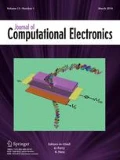Abstract
The Partial Element Equivalent Circuit (PEEC) method provides an electric equivalent circuit for a physical geometry. This circuit can be combined with external passive/active lumped elements, enabling the simulation and co-design of combined circuit and electromagnetic (EM) structures. The resulted circuit can be solved in a dedicated solver, or equivalently can be exported to a SPICE-like solver. In this paper, the inclusion of passive and active lumped circuit elements in PEEC method has been studied and a combined solver has been developed. To demonstrate the capability of the solver, three structures are examined. All examples include a transmission line-PEEC model and active components. Results are compared with those from OrCAD, where an analytical model for the transmission line is used. Good agreement between the results shows the feasibility of using PEEC to solve this type of mixed problems. Also, comparison has been made in terms of implementation and feasibility for the aim of developing the optimal EM solver with active elements support. It is shown that SPICE is not a suitable choice to solve the PEEC models and, a specialized solver can solve the system in a much faster way. On the other hand, all the definitions and models of circuit devices e.g. transistors, MOSFETs, etc. should be implemented in the specialized solver, which raises a trade-off between the solution time and the implementation time.













Similar content being viewed by others
References
Sui, W., Christensen, D.A., Durney, C.H.: Extending the two-dimensional FDTD method to hybrid electromagnetic systems with active and passive lumped elements. IEEE Trans. Microw. Theory Tech. 40(4), 724–730 (1992)
Pereda, J.A., Alimenti, F., Mezzanotte, P., Roselli, L., Sorrentino, R.: A new algorithm for the incorporation of arbitrary linear lumped networks into FDTD simulators. IEEE Trans. Microw. Theory Tech. 47(6), 943–949 (1999)
Orhanovic, N., Raghuram, R., Matsui, N.: Full wave analysis of planar interconnect structures using FDTD-SPICE. In: Proceedings of 51st Electronic Components and Technology Conference, 2001, pp. 489–494 (2001)
Guillouard, K., Wong, M.-F., Hanna, V.F., Citerne, J.: A new global finite element analysis of microwave circuits including lumped elements. IEEE Trans. Microw. Theory Tech. 44(12), 2587–2594 (1996)
Wu, H., Cangellaris, A.C.: Model-order reduction of finite-element approximations of passive electromagnetic devices including lumped electrical-circuit models. IEEE Trans. Microw. Theory Tech. 52(9), 2305–2313 (2004)
Ruehli, A.E.: Equivalent circuit models for three dimensional multiconductor systems. IEEE Trans. Microw. Theory Tech. MTT-22(3), 216–221 (1974)
Ruehli, A.E., Brennan, P.A.: Efficient capacitance calculations for three-dimensional multiconductor systems. IEEE Trans. Microw. Theory Tech. MTT-21(2), 76–82 (1973)
Ruehli, A.E.: Inductance calculations in a complex integrated circuit environment. IBM J. Res. Dev. 16(5), 470–481 (1972)
Ruehli, A.E., Garrett, J., Paul, C.R.: Circuit models for 3D structures with incident fields. In: Proc. of the IEEE Int. Symp. on Electromagnetic Compatibility, Dallas, TX, August, pp. 28–31 (1993)
Wollenberg, C., Gurisch, A.: Analysis of 3-d interconnect structures with PEEC using SPICE. IEEE Trans. Electromagn. Compat. 41(4), 412–417 (1999)
Safavi, S., Ekman, J.: On the route to full-wave electromagnetic modeling with active circuit element inclusion. In: 8th Workshop on Electromagnetic Compatibility of Integrated Circuits (EMC Compo), pp. 257–262 (2011)
Antonini, G.: Full wave analysis of power electronic systems through a peec state variables method. In: Proceedings of the 2002 IEEE International Symposium on Industrial Electronics (ISIE 2002), vol. 4, pp. 1386–1391 (2002)
Ekman, J.: Electromagnetic modeling using the partial element equivalent circuit method. Ph.D. thesis, Luleå University of Technology, March (2003)
Ruehli, A.E., Miekkala, U., Bellen, A., Heeb, H.: Stable time domain solutions for EMC problems using PEEC circuit models. In: Proc. of the IEEE Int. Symp. on Electromagnetic Compatibility, Chicago, IL, August (1994)
Wedepohl, L.M., Jackson, L.: Modified nodal analysis: an essential addition to electrical circuit theory and analysis. Eng. Sci. Educ. J. 11(3), 84–92 (2002)
Nagel, L.W.: SPICE2: a computer program to simulate semiconductor circuits. Ph.D. thesis, EECS Department, University of California, Berkeley (1975)
Yu, H., Chu, C., Shi, Y., Smart, D., He, L., Tan, S.X.-D.: Fast analysis of a large-scale inductive interconnect by block-structure-preserved macromodeling. IEEE Trans. Very Large Scale Integr. (VLSI) Syst. 18(10), 1399–1411 (2010)
Kielkowski, R.M.: Inside SPICE, 2nd edn. McGraw-Hill, New York (1998)
Pillage, L.: Electronic Circuit and System Simulation Methods (SRE), 1st edn. McGraw-Hill, New York (1999)
Antognetti, P., Massobrio, G.: Semiconductor Device Modeling with SPICE, 2nd edn. McGraw-Hill, New York (1993)
Ngspice User’s Manual. Available online: http://ngspice.sourceforge.net/docs.html
Cadense, O.: Available online. http://www.cadence.com/products/orcad/pages/default.aspx
Ruehli, A.E., Antonini, G., Esch, J., Ekman, J., Mayo, A., Orlandi, A.: Nonorthogonal PEEC formulation for time- and frequency-domain EM and circuit modeling. IEEE Trans. Electromagn. Compat. 45, 167–176 (2003)
Sedra, A.S., Smith, K.C.: Microelectronic Circuits Revised Edition, 5th edn. Oxford University Press, New York (2007)
Stevanovic, I., Cottet, D., Wider, B., Daroui, D., Ekman, J.: Modeling of large bus bars using PEEC method and circuit level simulators. In: IEEE 12th Workshop on Control and Modeling for Power Electronics (COMPEL), pp. 1–7 (2010)
Author information
Authors and Affiliations
Corresponding author
Rights and permissions
About this article
Cite this article
Safavi, S., Ekman, J. Feasibility analysis of specialized PEEC solvers in comparison to SPICE-like solvers. J Comput Electron 11, 440–452 (2012). https://doi.org/10.1007/s10825-012-0425-8
Published:
Issue Date:
DOI: https://doi.org/10.1007/s10825-012-0425-8




